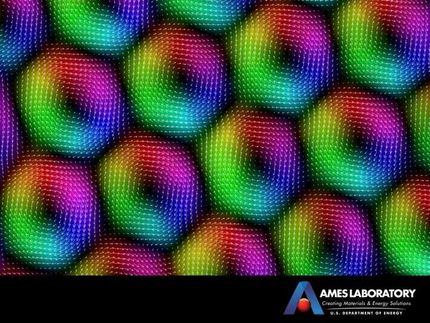Pave the way for more energy efficient technology
An international team of scientists led by physicists from the University of York has paved the way for a new class of magnetic materials and devices with improved performance and power efficiency.
Magnetic materials are currently used to store almost all digital information. However, with information processing and storage now making up a significant fraction of the world's energy consumption, continuing improvements in energy efficiency will require new technologies and materials.
A promising development is all-optical thermally induced magnetic switching (TIMS), which uses ultrafast laser pulses to change the magnetic state of the material, equivalent to writing a single bit of data. In all-optical switching there is no need to use magnetic fields to write the data and so a significant reduction in power consumption can be made. Moreover, the deposited laser energy per written bit is much smaller.
Until now, only rare-earth-transition-metal alloys called ferrimagnets have been shown to exhibit all-optical switching. However, these materials are both difficult to produce at the nanoscale necessary for technological devices and expensive due to their use of rare-earth metals such as Gadolinium (Gd) and Terbium (Tb).
Now new research, led by York's Department of Physics and involving scientists from Helmholtz-Zentrum Berlin (HZB), Germany and Radboud University Nijmegen, the Netherlands offers a new possibility for all-optical switching.
The research, published in Applied Physics Letters, demonstrates the use of a synthetic ferrimagnet - a sandwich of two ferromagnetic materials and a non-magnetic spacer layer. The spacer layer engineers the coupling between the two ferromagnets so that they align opposite to one another. When subjected to an ultrafast laser pulse this structure spontaneously switches its magnetic state representing writing a single bit of data.
Corresponding author Dr Richard Evans, from York's Department of Physics, said: "Energy efficiency is one of the most important goals for technological devices due to their expanding use with an increasing world population and resultant demand for energy.
"The synthetic ferrimagnet structure overcomes the intrinsic problems of rare-earth-transition-metal alloys and paves the way for a new class of magnetic materials and devices with improved performance and power efficiency. The results are a significant step towards realising a device based on thermally induced switching as it shows that structures on the nanometre length scale can be used."
Co-author Professor Theo Rasing, Head of the Department Spectroscopy of Solids and Interfaces at Radboud University Nijmegen, said: "Since our original discovery of all-optical-switching of magnetic domains in these ferrimagnetic alloys more than five years ago, the fruitful collaboration between our experimental efforts, the possibilities provided by the unique instrumentation of the Helmholtz-Zentrum and the theoretical insight provided by the York team, has led to this truly European success."
Organizations
Other news from the department science

Get the chemical industry in your inbox
By submitting this form you agree that LUMITOS AG will send you the newsletter(s) selected above by email. Your data will not be passed on to third parties. Your data will be stored and processed in accordance with our data protection regulations. LUMITOS may contact you by email for the purpose of advertising or market and opinion surveys. You can revoke your consent at any time without giving reasons to LUMITOS AG, Ernst-Augustin-Str. 2, 12489 Berlin, Germany or by e-mail at revoke@lumitos.com with effect for the future. In addition, each email contains a link to unsubscribe from the corresponding newsletter.



























































